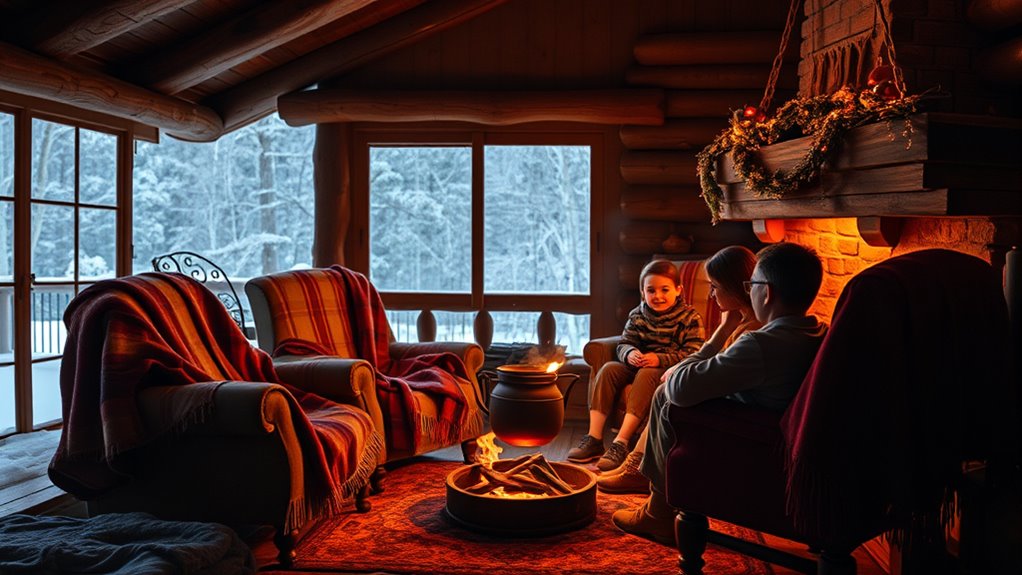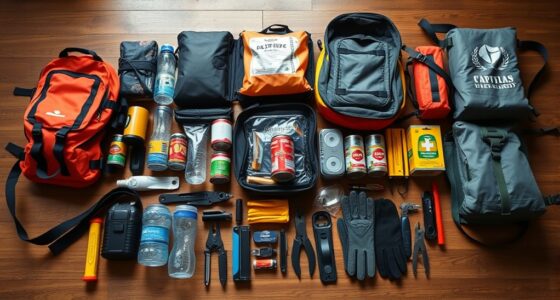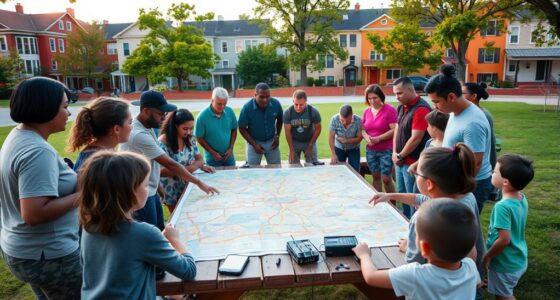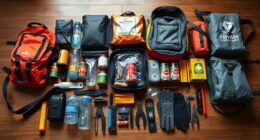To stay warm during winter storms without power, seal gaps around windows and doors, insulate your attic and walls, and use heavy curtains overnight. Dress in layered, moisture-wicking, and waterproof clothing, and keep moving to generate body heat. Use safe alternative heaters with proper ventilation, avoid flammable materials, and expand your emergency supplies. Staying informed with weather updates and tips can improve your safety—discover more ways to keep warm and protected during winter storms.
Key Takeaways
- Insulate your home by sealing gaps, insulating walls and attic, and covering windows with heavy curtains or blankets.
- Use safe, indoor-compatible heat sources like fireplaces or propane heaters, ensuring proper ventilation and carbon monoxide detectors.
- Dress in layered, moisture-wicking, and insulated clothing, covering head, hands, and feet to retain body heat.
- Stay active with movement and body positioning to generate and conserve warmth.
- Prepare emergency supplies, including warm clothing, blankets, food, water, and a battery-powered radio for updates.
Insulating Your Home Effectively
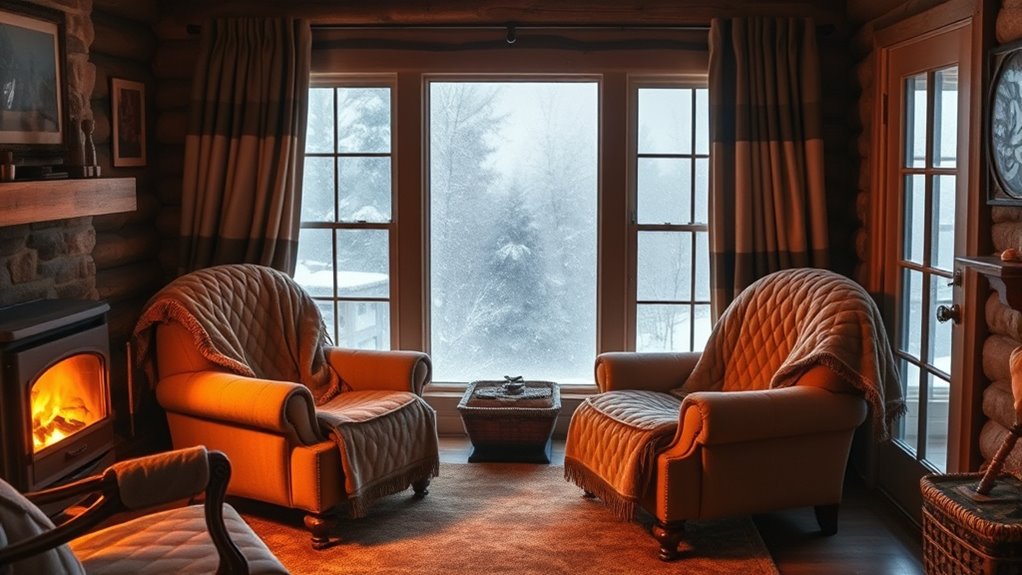
To keep warmth inside during a winter storm, insulating your home effectively is essential. Start by sealing gaps around windows, doors, and vents to prevent drafts that let cold air in. Add weatherstripping or caulking to create a tight barrier. Insulate your attic and walls with proper materials like fiberglass or foam boards, which trap heat and reduce heat loss. Don’t forget to insulate pipes to prevent freezing and bursting. Cover windows with heavy curtains or thermal blankets at night for extra warmth. Use draft stoppers at the base of doors to block cold air from entering. Proper insulation and sealing help retain heat, making your home more comfortable and energy-efficient during power outages caused by winter storms. Additionally, utilizing insulation techniques can significantly enhance your home’s ability to retain warmth and improve overall energy efficiency.
Using Alternative Heating Sources Safely
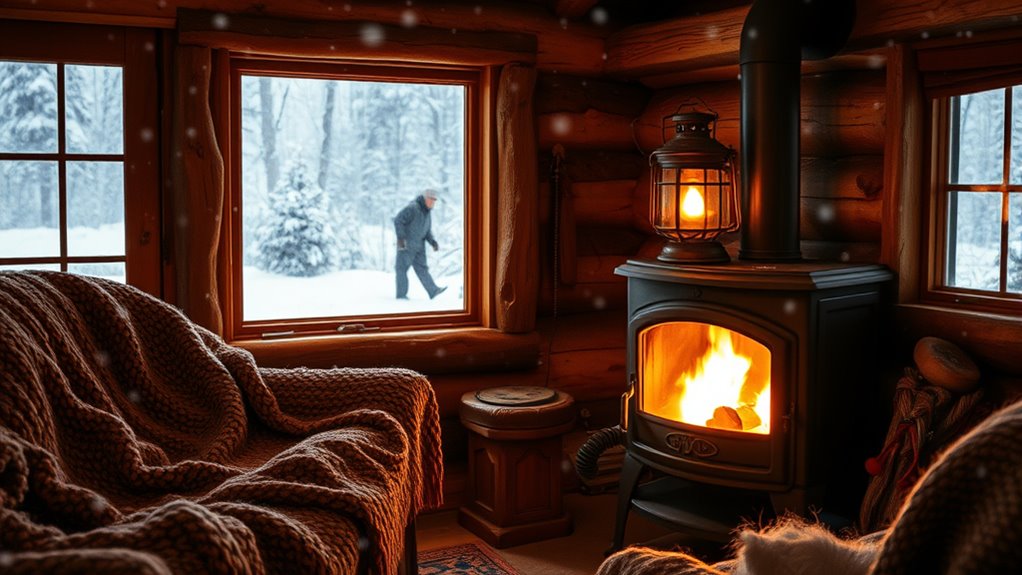
When power outages hit during a winter storm, using alternative heating sources can keep you warm, but it’s essential to do so safely. Always read manufacturer instructions, and never leave heating devices unattended. Guarantee proper ventilation to prevent carbon monoxide buildup, especially with fuel-burning options. Keep flammable materials away from heat sources, and use devices designed for indoor use. Install carbon monoxide detectors in your home if using fuel-based heaters. Regularly check for gas leaks or damage to heating equipment. Never use outdoor heaters or grills inside your home, as they pose serious safety risks. By following these precautions, you can stay warm without risking your safety or causing fires. Staying vigilant ensures you keep safe during winter storms while keeping warm.
Dressing Appropriately for Cold Conditions
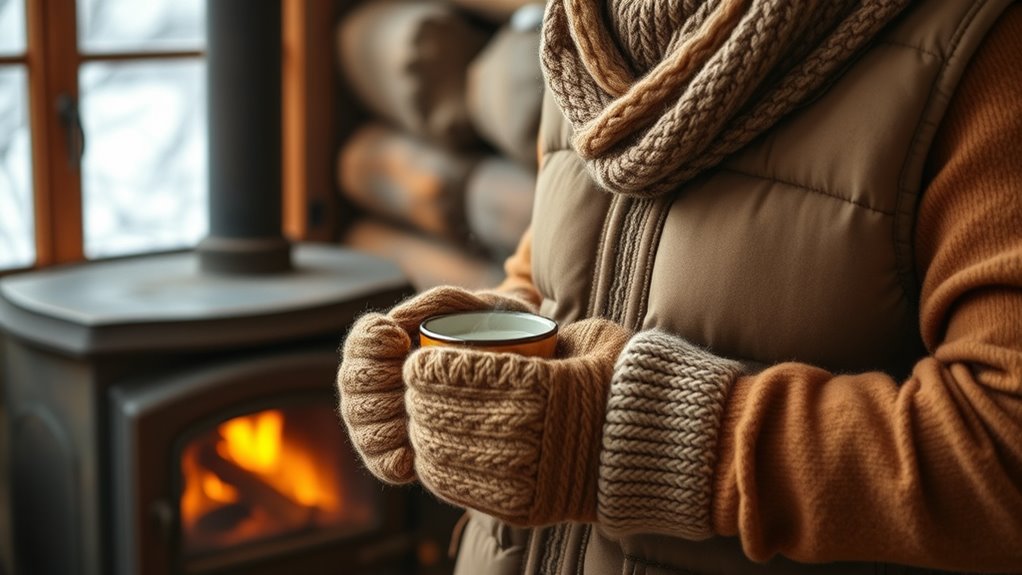
Dressing appropriately for cold conditions is essential to stay warm and prevent hypothermia or frostbite during winter storms. You should layer your clothing, starting with a moisture-wicking base layer to keep sweat away from your skin. Add an insulating layer like wool or fleece to trap body heat, then top it with a waterproof and windproof outer layer to shield against the elements. Make sure your head, hands, and feet are covered, as these areas lose heat quickly. Wear a hat, gloves, and insulated boots to preserve your body heat. Avoid tight clothing that restricts circulation, and choose loose-fitting layers for better insulation. Proper clothing helps retain warmth and keeps you comfortable and safe in harsh winter conditions. Using self-watering plant pots can help ensure your indoor plants stay healthy despite fluctuating temperatures indoors.
Creating Warmth Through Body Heat and Movement

Creating warmth through body heat and movement is one of the most effective ways to stay warm during winter storms. When you keep moving, your muscles generate heat that helps raise your core temperature. Simple activities like walking in place, jumping jacks, or stretching can make a significant difference. Staying active prevents your body from losing heat too quickly and helps you stay alert and warm. To maximize this, try to keep moving regularly, even if it’s just small exercises. Remember, movement also boosts circulation, which keeps your extremities warmer. Incorporating variety of materials can also help insulate your body and retain heat during these activities. Use body positioning to conserve heat, like huddling or curling up. Avoid sitting still for long periods to prevent cooling down.
Preparing Emergency Supplies and Staying Informed

Staying safe during winter storms requires you to be proactive in preparing your emergency supplies and staying informed. Gather essentials like non-perishable food, bottled water, blankets, warm clothing, and a flashlight with extra batteries. Keep a first aid kit handy and include any necessary medications. Having a battery-powered or hand-crank radio guarantees you receive weather updates and emergency alerts without power. Make a plan for how to communicate with family members if you get separated, and share your plan with them. Regularly check weather forecasts and local advisories. Store supplies in an accessible location, and rotate them to prevent expiration. Being aware of emergency preparedness strategies can further improve your safety during severe winter conditions. Staying informed and prepared helps you respond quickly, reducing risks and keeping you warm and safe during winter storms.
Frequently Asked Questions
How Can I Prevent Pipes From Freezing Without Power?
You can prevent pipes from freezing without power by insulating them with foam or newspaper, especially in unheated areas. Let a faucet drip slightly to keep water moving, reducing the chance of freezing. Open cabinet doors to allow warmer air to reach pipes, and keep interior doors closed to retain heat. If possible, use a space heater safely in your home to raise the temperature near vulnerable pipes.
What Are the Safest Ways to Generate Heat Indoors?
Did you know that space heaters can raise indoor temperatures by up to 10°F in just an hour? To stay warm safely, use a portable electric heater with a tip-over switch and keep it away from curtains and furniture. Always place heaters on level surfaces, never leave them unattended, and make certain your room has proper ventilation. Never use outdoor heating devices inside, as they pose carbon monoxide risks.
How Do I Stay Warm if My Heating System Fails?
If your heating system fails, you can stay warm by layering clothing, using blankets, and sealing drafts around windows and doors. Gather in small, insulated spaces to conserve heat, and consider using a fireplace, wood stove, or portable heater safely. Drink warm liquids, move around to generate body heat, and keep your head and extremities covered. Always prioritize safety and avoid using unvented heating devices indoors.
Can Animals Survive Winter Storms Without Power?
Animals can survive winter storms without power if you provide proper care. You must shelter them from wind and cold, guarantee they have dry, insulated bedding, and offer extra food and water to maintain energy. Keep their environment secure from drafts, and monitor their health closely. By giving warmth, protection, and nourishment, you help animals endure harsh winter conditions and increase their chances of survival.
What Are Signs of Hypothermia and Frostbite to Watch For?
You should watch for signs of hypothermia like shivering, confusion, slurred speech, exhaustion, and bluish skin, especially in extremities. For frostbite, look for numbness, white or grayish-yellow skin, and hard or waxy areas on fingers, toes, nose, or ears. If you notice any of these symptoms, seek warmth immediately and consult a healthcare professional to prevent further damage. Stay alert and keep yourself wrapped up.
Conclusion
Think of yourself as a sturdy lighthouse, standing strong through the storm. By insulating your home, using safe heating methods, dressing warmly, and staying active, you become a guiding beacon of safety. Keep your emergency supplies close, and stay informed like a vigilant sailor steering through rough seas. With these steps, you’ll weather winter storms unscathed, shining bright and warm, no matter how fierce the wind blows. Stay prepared, and let your resilience be your guiding light.

